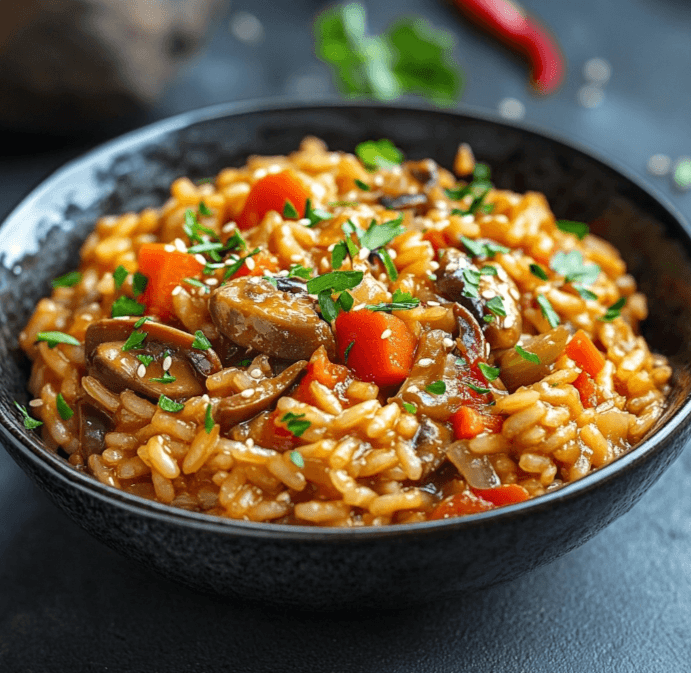Is risotto healthy? This is a common question among food enthusiasts who love this creamy Italian dish but are unsure if it fits into a nutritious diet. Risotto, traditionally made with Arborio rice, broth, butter, and Parmesan cheese, is often viewed as indulgent comfort food. However, with a few simple adjustments, risotto can be transformed into a balanced and nutritious meal that supports a healthy lifestyle.
This comprehensive guide will dive into whether risotto is healthy, its nutritional profile, health benefits, potential downsides, and how to make it a more wholesome dish. We’ll also cover various delicious variations and answer frequently asked questions to help you enjoy risotto guilt-free.
Table of Contents
What is Risotto?
To understand is risotto healthy, it’s important to know how this dish is made. Risotto is a Northern Italian rice dish prepared by cooking short-grain rice like Arborio rice in broth. The rice’s starches are released during cooking, creating a rich, creamy texture without requiring cream.
Ingredients in Traditional Risotto
- Arborio Rice: A high-starch, short-grain rice perfect for achieving risotto’s creamy consistency.
- Broth: Chicken, beef, or vegetable stock is used to infuse flavor into the dish.
- Butter or Olive Oil: Adds richness and enhances the dish’s texture.
- White Wine: Used for deglazing the pan and adding acidity.
- Parmesan Cheese: Gives the dish its signature nutty and savory flavor.
For those curious about the origins of risotto, you can explore Is Risotto Italian or French? for a detailed look at its history.

Nutritional Profile of Risotto
The question is risotto healthy often depends on its ingredients. Here’s a typical nutritional breakdown for one serving (1 cup) of traditional risotto:
Average Nutritional Values
- Calories: 350–450 kcal
- Carbohydrates: 45–60g
- Protein: 8–12g
- Fat: 10–15g
- Fiber: 2–3g
- Sodium: 600–800mg (varies with the type of stock and cheese used)
Nutritional Highlights
- Arborio Rice: Provides a steady energy source through its high carbohydrate content. It’s naturally gluten-free, making it suitable for those with gluten sensitivities.
- Stock: Adds flavor and essential minerals like potassium and magnesium, especially when homemade.
- Parmesan Cheese: A rich source of calcium and protein but contributes to higher fat and sodium levels.
- Butter: Enhances flavor but adds saturated fat.
If you want to make risotto healthier, consider incorporating fresh vegetables or lean proteins. You can explore this collection of healthy vegetable-based recipes to add more nutrients to your risotto.
Is Risotto Healthy?
Is risotto healthy? The answer is yes—if it’s prepared with the right ingredients and portioned carefully. Let’s break down why risotto can be a nutritious addition to your diet.
7 Reasons Why Risotto is Healthy
- A Reliable Energy Source
The carbohydrates in Arborio rice provide sustained energy, making risotto a great option for active individuals. - Supports Digestive Health
Risotto can be rich in fiber when vegetables or whole grains are added. Fiber supports gut health by promoting regular digestion. - Calcium for Bone Health
Parmesan cheese contributes a good amount of calcium, which is essential for maintaining strong bones and teeth. - Gluten-Free Comfort Food
Since Arborio rice is naturally gluten-free, risotto is an excellent choice for people with gluten intolerance or celiac disease. - Customizable to Your Needs
Risotto is versatile and can be tailored to include lean proteins, vegetables, or even alternative grains like quinoa for added nutrition. - Rich in Antioxidants
Adding ingredients like spinach, mushrooms, and herbs boosts risotto’s antioxidant content, which can help reduce inflammation. - A Filling and Satisfying Dish
Risotto’s creamy consistency makes it satisfying and comforting, allowing for smaller portions that still feel indulgent.
Potential Downsides of Risotto
While risotto has several health benefits, there are potential downsides to traditional recipes:
- High Calorie Count: Ingredients like butter, cheese, and oil can make risotto calorie-dense.
- Excess Sodium: Store-bought stocks and Parmesan cheese can contribute to higher sodium levels, which may impact heart health.
- Low Fiber Content: Arborio rice has lower fiber compared to whole grains like quinoa or farro.
How to Make Risotto Healthier
Making risotto healthier is simple with a few modifications. Here are practical tips:
- Use Low-Sodium Stock
Replace traditional stock with a low-sodium vegetable version to reduce salt intake. - Add Vegetables
Incorporate nutrient-rich vegetables like mushrooms, zucchini, spinach, or bell peppers. These add fiber, vitamins, and minerals without extra calories. - Reduce Cheese
Limit Parmesan cheese or use nutritional yeast as a dairy-free alternative to cut fat and sodium. - Swap Butter for Olive Oil
Olive oil provides healthier fats while maintaining the richness of the dish. - Experiment with Alternative Grains
Replace Arborio rice with quinoa, farro, or barley for a higher fiber and protein content.
Want to learn more about how fiber can benefit your health? Read this detailed guide on the benefits of fiber.
Popular Risotto Variations
One of the reasons risotto remains a favorite is its adaptability. Here are some popular variations:
Wild Mushroom Risotto
Mushrooms add umami flavor and antioxidants, making this variation both delicious and nutritious. Check out Wild Mushroom Risotto with Parmesan for an easy and flavorful recipe.
Seafood Risotto
Seafood risotto features shrimp, scallops, or fish, adding lean protein and omega-3 fatty acids.
Vegan Risotto
Skip the cheese and use vegetable stock along with nutritional yeast for a creamy, dairy-free option.
Vegetable Risotto
This colorful dish includes vegetables like asparagus, peas, and butternut squash, boosting its vitamin and mineral content.
Quinoa Risotto
For a twist, swap Arborio rice with quinoa. This variation offers a higher protein and fiber content while retaining the creamy texture.
Looking for more risotto ideas? Check out the Best Risotto Near Me Guide for creative restaurant-style inspiration.
FAQs About Risotto
Is risotto gluten-free?
Yes! Arborio rice is naturally gluten-free, and using gluten-free stock ensures the dish remains safe for people with gluten sensitivities.
Can risotto be made ahead of time?
Risotto is best served fresh, but you can make it ahead and reheat it. Add a splash of stock while reheating to restore its creamy texture.
How can I reduce calories in risotto?
- Use olive oil instead of butter.
- Limit cheese and replace it with nutritional yeast.
- Add vegetables to increase volume without adding many calories.
Is risotto a main dish or a side?
It can be both! Risotto is hearty enough to be served as a main course but also works well as a side dish for grilled fish or chicken.
Conclusion
So, is risotto healthy? The answer depends on how you prepare it. By using wholesome ingredients, adding vegetables, and moderating high-fat components, risotto can be a nutritious and satisfying dish.
For inspiration, try this Wild Mushroom Risotto with Parmesan or explore other creative options with the Best Risotto Near Me Guide.
With a few mindful changes, risotto proves that comfort food can also nourish the body and soul. Whether you prefer traditional or modern variations, there’s always a way to make risotto both healthy and delicious.

